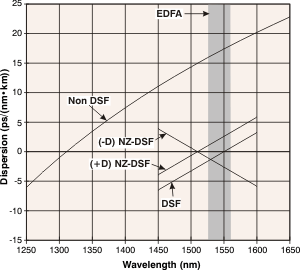| Fiber Types | |||||
|
Source: David R. Goff. Fiber Optic Video Transmission, 1st ed. Focal Press: Woburn, Massachusetts, 2003 and other private writings. |
|||||
|
Key Single-Mode Fiber Types
There are three basic classes of single-mode fiber that are used in modern telecommunication systems. The oldest type, and still the most widely deployed, is NDSF or Non-DSF (Non-Dispersion-Shifted Fiber.) NDSF was the first successful single-mode fiber. Most of the existing fiber base in the U.S. in the late 1990's was NDSF fiber. NDSF was used in early systems because the fiber was optimized for operation at 1310 nm, the wavelength of choice at that time. Later, 1550 nm systems were introduced. NDSF was thought to be ill-suited for use at 1550 nm because it had high dispersion at that wavelength, limiting the maximum data transmission rate and distance. To address this shortcoming, DSF (Dispersion-Shifted Fiber) was introduced. DSF was optimized for operation at 1550 nm. Years later would it would be discovered that while DSF worked very well with a single wavelength at 1550 nm, it exhibited serious nonlinearities when multiple, closely-spaced wavelengths in the 1550 nm band were transmitted, as in DWDM systems. Recently, to address the problem of nonlinearities, a new class of DSF fibers have been introduced. These are called NZ-DSF (non-zero dispersion-shifted fiber). They are available in both positive and negative dispersion varieties. These NZ-DSF fibers are now the fibers of choice where new fiber must be deployed. Figure 1 shows the dispersion of the common types of single-mode fibers used in modern telecommunication systems. |
Figure 1 - Dispersion of Common Types of Single-Mode Fiber |
||||
|
NDSF: Commonly referred to as standard single-mode silica fiber, this optical fiber is also known as non-dispersion-shifted fiber (NDSF). SMF-28, made by Corning, is among the most popular NDSF fibers deployed today. NDSF exhibits zero chromatic dispersion (called λ0) at a wavelength of 1310 nm. Transmission wavelengths used with Erbium doped fiber amplifier (EDFA) systems (1550 nm window) undergo significant chromatic dispersion with NDSF and require dispersion compensation, particularly at 10-Gbit/s or higher data rates. Typical optical losses range from 0.21 to 0.25 dB/km.
DSF: To minimize chromatic dispersion at 1550 nm, a new fiber called dispersion-shifted fiber (DSF) was introduced in the early 1980's. By changing the index profile and reducing the core radius, fiber designers were able to move λ0 from the 1310 nm window to the 1540 to 1560 nm window. Though effective in greatly reducing chromatic dispersion effects, which limits bandwidth, the positioning of λ0 in close proximity to the operating wavelengths resulted in a tendency to a nonlinear distortion effect called four wave mixing (FWM). This is especially troublesome in DWDM applications with more than eight wavelengths. Typical losses range from 0.25 to 0.30 dB/km.
NZ-DSF: NZ-DSF was developed to counteract the FWM limitations of DSF. The idea is to move λ0 to either end of the 1550 nm band, thus ensuring that all of the wavelength channels have slightly different optical speeds in the fiber. Common brands are TrueWave Classic (λ0 < 1530 nm), TrueWave Plus (λ0 = 1497 nm), TrueWave RS (λ0 < 1452 nm) by Lucent, and SMF-LS (λ0 > 1560 nm) by Corning. The advantage that these fibers have over DSF is a compromise solution of a slightly lower degree of integrated dispersion compensation for a higher tolerance to non-linear distortion effects. Available with positive dispersion (+D) NZ-DSF and negative dispersion (-D) NZ-DSF. |
|||||
| Return to Top of Page | |||||
|
|||||

